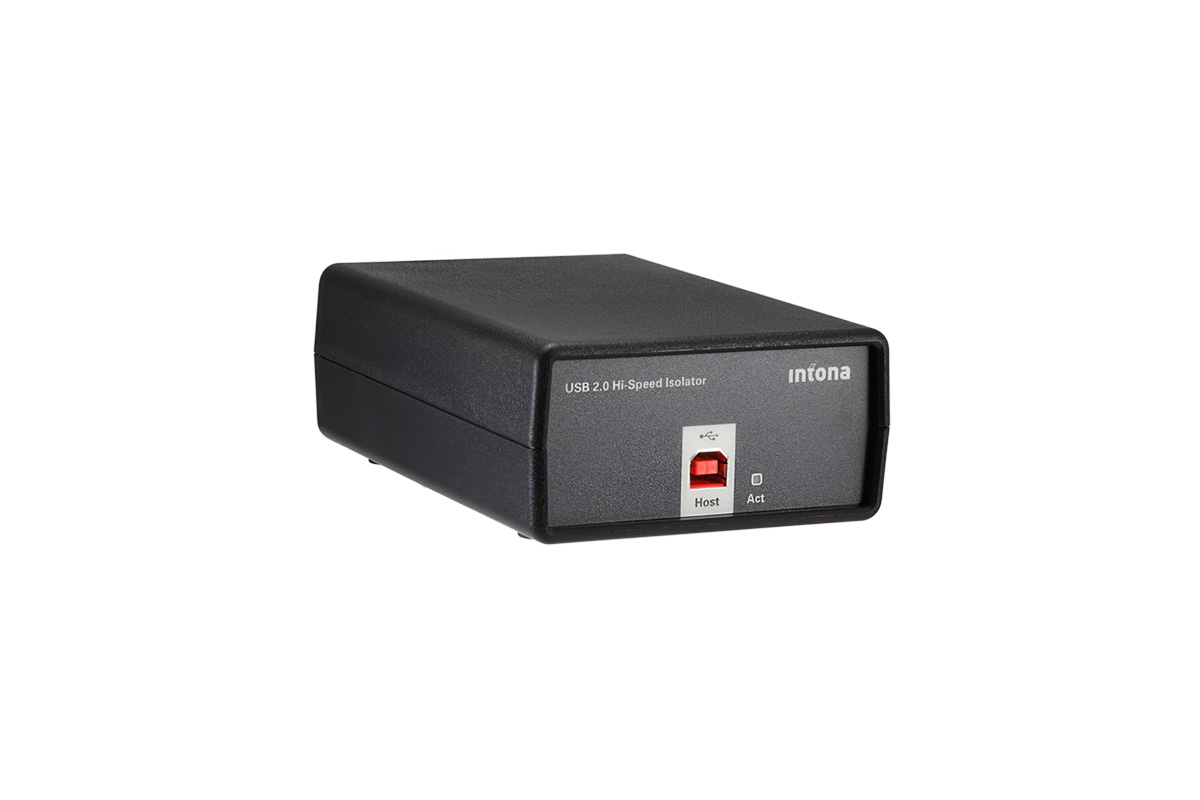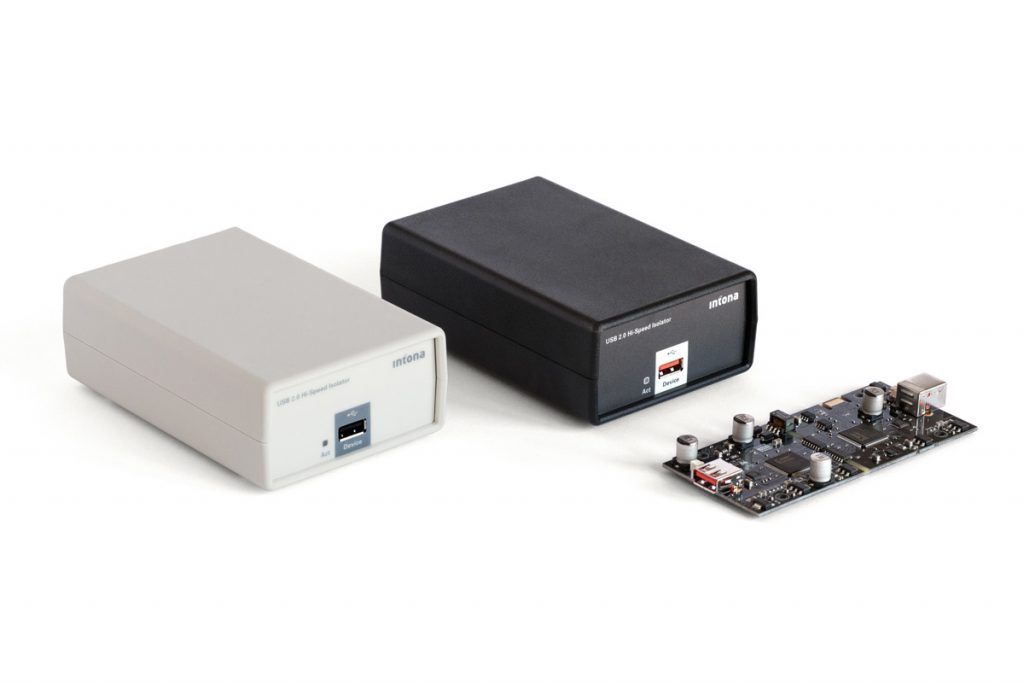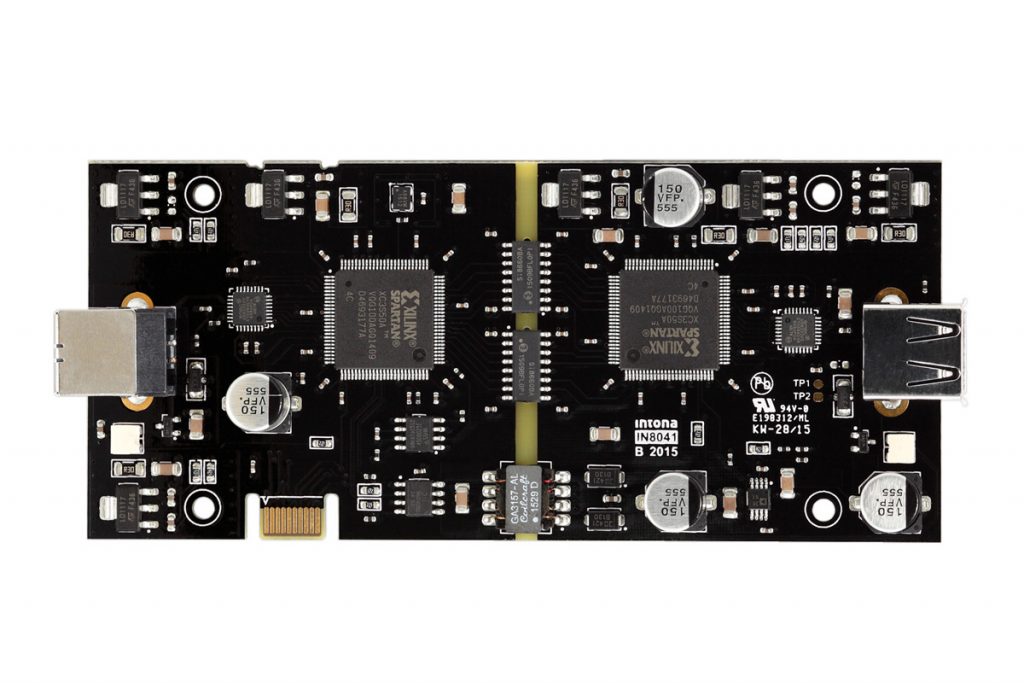USB 2.0 Hi-Speed Isolator is a product made by a German brand Intona. This was my first time to come in touch with a brand that’s not one of those big names in audio circles. The company has a range of products, with the most affordable of them being Standard Version for USD 229 / 209 EUR but the one we have here is an Industrial Version that goes for USD 319 / 289 EUR. Intona itself claims that this is their most popular product.
Build and Features
To put it short – USB 2.0 Hi-Speed Isolator uses an all-plastic case that looks as cheap as they get. It feels lightweight and hollow too. There are one USB input and one output, no power supply is needed, just insert it in your USB signal path and you’re ready to go. Here goes the full features list from the official webpage:
Features
- Provides galvanic isolation to the USB bus
- Compliant to USB 2.0 Hi-Speed (480 MBit/s)
- Backward compatible with Full Speed and Low Speed
- Isolation withstands up to 2.5kVRMS
- Advanced ESD protection (15kV IEC Air-gap Discharge)
- Works out of the box, no drivers needed
- Transparent to host and device: wide compatibility to all operating systems, embedded systems, and devices
- Works also with hubs and extenders
- Supports all USB-specific transfers and modes
- No additional round-trip latency
- Powered by USB bus, no separate power supply
- Ultra-quiet power rail isolation, linear regulation
- 300mA nominal (500mA max.) output current on the isolated side
- Connectors: host-side USB-B; device-side USB-A
- Status LED for each port showing bus state and speed
- Impedance controlled high-speed circuit design
- National compliances: FCC, CE, RCM, ICES-003
- IP 54 ABS housing
- Dimensions: 135 x 90 x 46 mm
- Engineered and manufactured in Germany
Testing
I had a chance to hear the impact of Intona USB Isolator in two different systems, in my own setup and in my friend’s. In both of these, positive effects were easily heard, but for some reason (nosier USB outputs probably) the difference was more meaningful in my own system. Anyway, let’s talk a bit more about what I was actually hearing.
The first thing I’ve noticed with Hi-Speed Isolator in place is how well behaved and springy the bassline has become. What was once thumpy and unwieldy tone now started to take finer shapes and curves. Going above the bassline, the soundstage is the next thing to catch my attention. It’s simply bigger and more developed in all directions – width, depth, and even height. At the same time, instruments are placed more securely and better separated. Listening to your music this way for some time will make it hard to return to the previous state – without a USB conditioner. Taking Intona out of the equation made bassline seem bloated and soundstage small and cluttered.
Comparison
Some of the regular readers might remember that I’ve already tested two other USB conditioners – Schiit Wyrd and iFi nano iUSB3.0. Wyrd left a very mild impression and I found iFi nano to perform its tasks better, so I kept nano in my system. That means I was able to directly compare the effect of it and the Intona isolator in my setup.
As I mentioned, I’m quite happy with the positive effects of nano iUSB3.0, calmness and depth it brought to the table. That said, in my system, Intona simply worked better and had an even bigger impact. All tones were better developed, with more space to breathe, and the baseline felt less bloated. This basically made it a no brainier battle as in my system Intona simply works its magic better.
Now, this is a place I feel obligated to mention that the findings of some other audiophiles in their system differed from mine. This is quite logical and basically expected since iFi and Intona used different approaches to the problem. iFi nano is a reclocker and regenerator with its own low noise power supply, while Intona doesn’t use any power supply but adds galvanic isolation on top of regeneration (a feature that more expensive iFi micro posses too).
These different features affect signal conditioning differently and it’s quite possible that the effectiveness of either device is very dependent on the dominant type of pollution your USB connection carries and your DAC is sensitive to. So please take my experience with a healthy reserve as Intona Hi-Speed Isolator might not work better than iFi nano in all systems.
Conclusion
Worth mentioning, in the end, is that I didn’t get the Intona Isolator from the manufacturer, I didn’t even purchase it myself. It’s actually a loan from a friend (if you read this – thanks) and I had every desire to find that the conditioner I already own works better or at least as good. Unfortunately, this inconspicuously looking plastic box caught me off guard with how skillful of a conditioner it proved itself to be in my system.
As far as recommendations go, if there’s a chance I suggest you at least give it a try and see what it can do for your own system. I’ll put a hold on purchasing one myself for now since I’m trying to transition to a SPDIF connection at the moment, but if I ever decide to commit to a USB again, Intona conditioners will be high on my wish list.







Several years ago I decided that I wanted my desktop PC to be my “all in one” AV source. However since then I have been aware that this decision has had some sonic drawbacks. After watching your review of the Intona, and quite a lot of google research, I ordered an Intona 2.0 and it arrtived yesterday. Even after one day of listening it is clear that the Intona gives a significant lift in SQ to my system as it did in yours. Now, I think that the compromises of using a PC as a source have, to a large extent, been over overcome. My chain is now: Desktop PC / Intona 2.0 / Singxer SU-6 / I2S to Gustard R26 / DIY Mofo type Class A Monoblock amps. Thanks for the your reviews which have helped me make some very satisfactory purchasing decisions 🙂